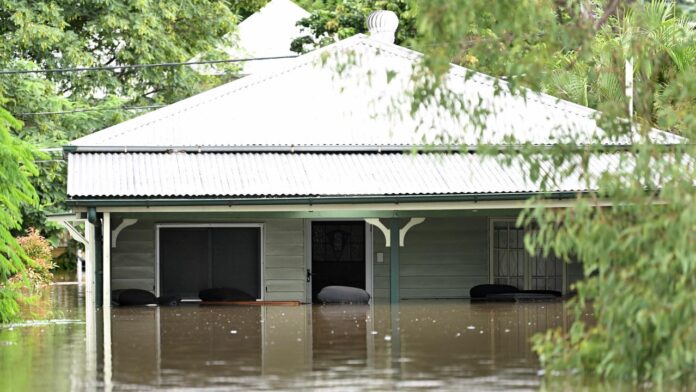[ad_1]
Australians who suffered through devastating flooding events in 2022 were let down by the insurance industry, and mistakes should not be repeated, consumer advocacy groups say.
In the first public hearing of a federal parliamentary inquiry into the responses of insurance companies during the year of natural disasters, the behaviour of assessors and third-party contractors has been described as “appalling”.
Consumer rights groups say the volume of claims was “no excuse” for poor behaviour.
“We have just seen example after example of sometimes appalling behaviour, really rude, aggressive, bullying behaviour, where third parties come to a person’s house and either accuse them of letting their house fall into disrepair or accuse them of insurance fraud, basically,” Julia Davis from the Financial Rights Legal Centre told the inquiry.
Queensland, NSW, Victoria and Tasmania were lashed by major flooding throughout 2022, with a submission from the Insurance Council of Australia estimating the total cost of claims lodged to be nearly $7.4bn.
The group said there were 303,407 insurance claims lodged – 230,000 of which came from southeast Queensland and northern NSW – which has been hit again by recent summer storms.
The inquiry is considering the experiences people had dealing with their insurance company amid complaints of bad behaviour, and the challenges insurers faced in responding to the record number of claims.
She said there were also problems around processing delays, which had gone on to exacerbate the trauma for many victims of flooding.
“A lot of that could be alleviated if insurers were better at staying in touch, calling when they say they’re going to call,” she said.
“It’s when the insurer doesn’t make contact for months and doesn’t call back when they say they will that consumers start to go crazy.”
Paul Holmes, the assistant director of disaster relief for Legal Aid Queensland, said the way insurers communicated with claimants “has to improve”.
He told the inquiry that policy holders who have a poor claims experience found the entire process “stressful and overwhelming, lengthy, difficult, inconvenient, frustrating, and traumatising”.
The solution, he said, was “prompt, clear, trauma informed and friendly communication” from the first phone call and for contentious clauses like wear-and-tear be rewritten.
He also cited concerns about the complex language often used in insurance policies, and said documents should be shorter and use plain language.
“Wear and tear maintenance has given me the most grief here at LAQ. Some of the insurers are sick of hearing me whinging about it,” he told the inquiry.
More broadly, the inquiry heard the culture of the insurance industry needed to change.
Philippa Heir, from the Consumer Action Law Centre, said too often consumers were having their claims declined on “spurious grounds”.
“It appears from our perspective that it comes from a culture where the first thought for the assessor is, ‘How can I decline this claim?’, not, ‘How can I pay this claim’,” she said.
The inquiry is being asked to consider how to best reform the industry to ensure the experiences of many claimants in 2022 doesn’t happen again.
The Insurance Council of Australia and other major insurance groups will begin giving evidence to the inquiry next week.
Ahead of their appearance, the council has submitted a pre-budget submission to the federal government, calling for an ongoing fund of $250m a year to buy back and raise homes exposed to extreme flood risk.
The group said the fund should be matched by the states and territories, ensuring that $500m is available each year to move 750 households out of flood danger zones every year.
“The major flooding events over this summer and back to 2022 have demonstrated the scale of the challenge Australia faces in responding to extreme weather events, and why more investment is urgently needed to better protect Australian lives and properties,” chief executive Andrew Hall said.
“The cost of insurance has seen a significant increase over the past 12 months, driven by the impact of flood events, building and repair cost inflation, and the cost of reinsurance.
While there is no one solution that would immediately work to counter these factors, collectively the measures outlined in our Pre-Budget submission work to relieve upward pressure on premiums by reducing risk, which is the ultimate driver of insurance costs, and so support the community’s need for action on cost of living. ”
[ad_2]
Source link


